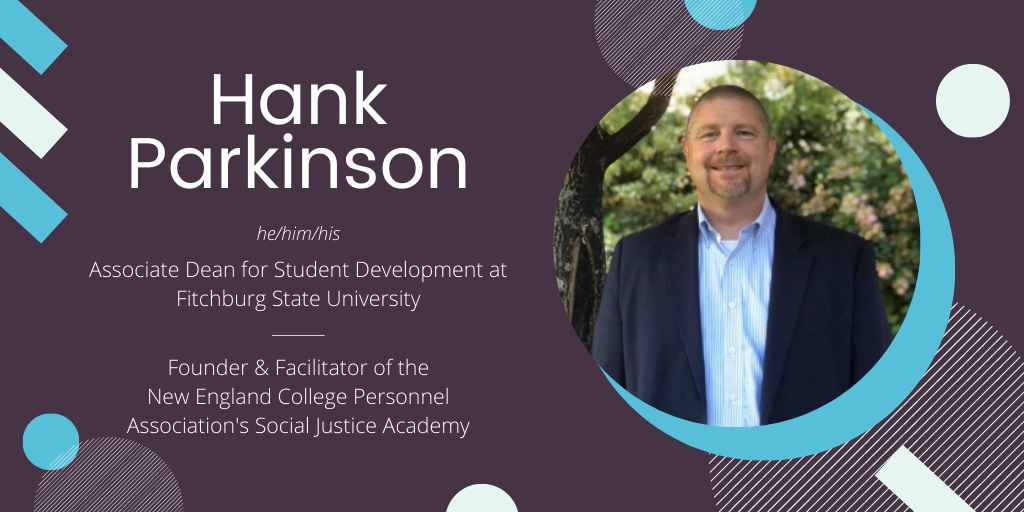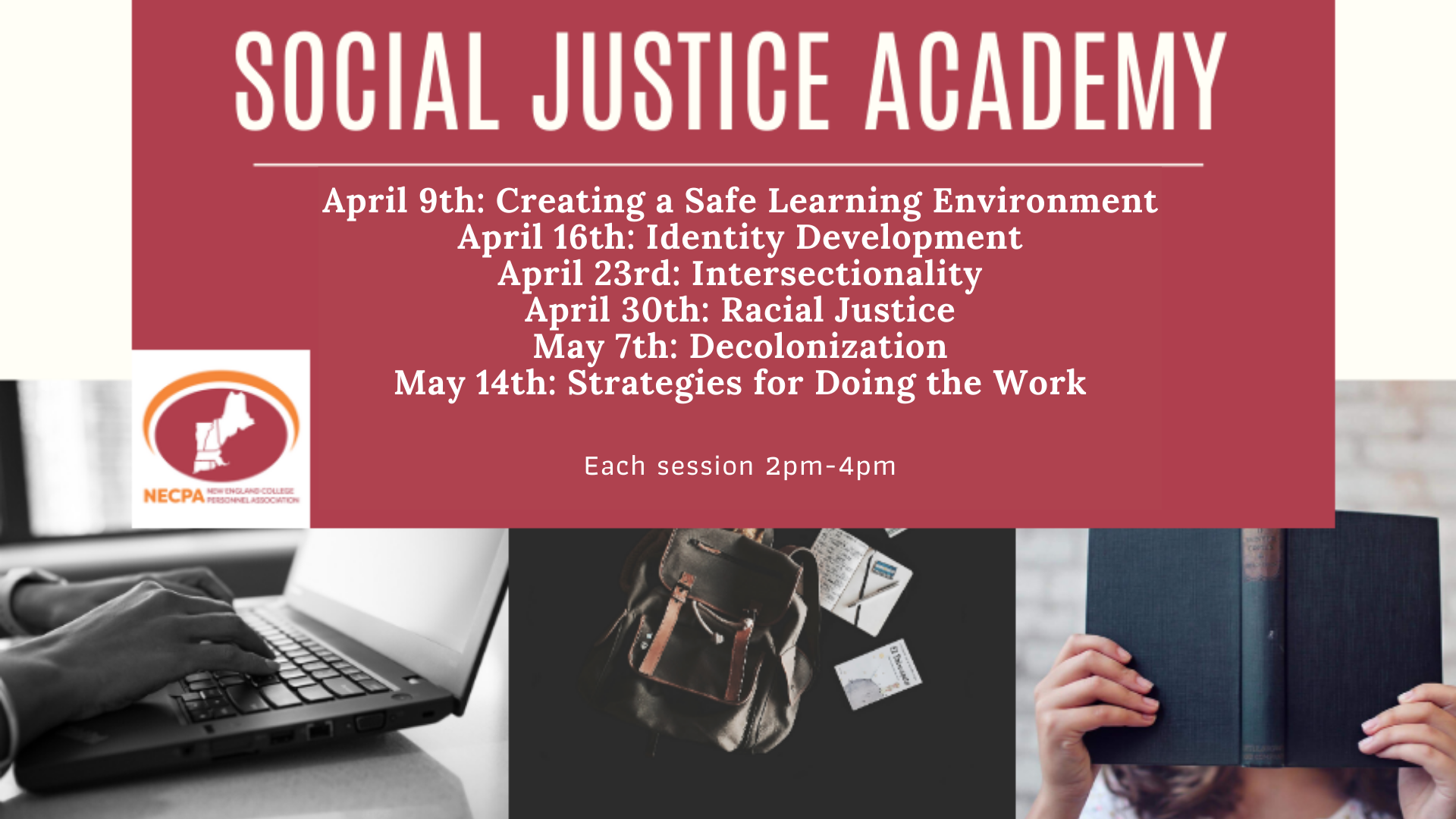Diversity, inclusion, and equity are all essential topics to discuss with students, faculty, and staff on your campus.
However, initiating these conversations may seem intimidating.
To help solve that, I consulted Hank Parkinson, the Associate Dean for Student Development at Fitchburg State University. Hank founded and has been facilitating ACPA New England’s Social Justice Academy for the past two years.

The Social Justice Academies are focused on developing student affairs professionals’ knowledge of diversity, equity, and inclusion. Sessions are aimed at empowering participants to become change agents on their campuses. More than 40 SA pros have participated in these weekly reflection-focused discussions.

flier for the 2020 Social Justice Academy
Surveys at the end of the academies show that participants have taken away new resources, ideas, practices, and a better understanding of the social justice challenges facing themselves and their students.
Read on, as I’ll use Hank’s expertise and experience with the academies to share tips for how you can start campus conversations related to equity, inclusion, and social justice.
1. Take the initiative
Starting a social justice initiative had been on Hank’s mind after reading ACPA’s Framework for Racial Justice and Decolonization. He began to believe that despite many higher education professionals and organizations boasting about diversity within the field, reality doesn’t match up; higher education is still a bubble, built foremostly for white, able-bodied men.
So, he asked himself, “How can I address the systemic issues within higher education?”
Hank believes that the hardest step toward addressing social justice challenges is getting started. It’s imperative to realize how much these conversations are needed, that it’s our job as SApros to facilitate them, and that students are noticing three types of people around them: those who are only talking about inclusion, those are taking action in small ways or in their personal lives, and those are committed to supporting their students’ identities through meaningful change.
Taking the initiative to start these conversations can often be the most intimidating step but is vital to do something to get the ball rolling on creating truly inclusive campuses.
2. Create a team of individuals from different backgrounds
As a white, cisgender male, Hank knew that he needed the perspectives of individuals with other identities, including historically marginalized backgrounds, in order to properly design the Social Justice Academy.
When planning your own conversation on campus, seek out committee members who not only bring different perspectives to your own (based on their personal backgrounds) but also have different roles on campus — including in departments outside of student affairs. This will help increase buy-in, knowledge, and resources within the planning committee.
Avoid tokenizing on your committee, defined as diversity without inclusion, by spreading the invitation to join the committee as much as possible throughout campus staff communications. You should also invite individuals to “test out” committee membership before fully devoting themselves to it and emphasize that diversity and inclusion is the main policy of the committee, not just a checkbox.
3. Pick topics based on current and local events
The ACPA planning committee picks the topics for the Social Justice Academy based on two factors: the audience’s needs and current events. The 2021 academy’s topics included intersectionality, identity development, and decolonization.
However, the presentations did not always strictly stick to the agendas. The facilitators created space for participants to discuss and reflect upon ongoing news, such as the Derek Chauvin trial and the recent increase in violence against Asian Americans.
In your own social justice conversations, be mindful of events that have happened on or near your campus. The Society for Human Resources Management recommends “providing healthy opportunities for respectful dialogue.”
This could include giving trigger warnings regarding the content you’ll cover, hosting listening sessions, and being mindful of your institutions’ values. You could also follow in the Social Justice Academies’s footsteps by having participants define the rule sets and values as a group within your first session together.
4. Make the discussion itself accessible and inclusive to all
Students and staff won’t be able to engage with your workshops if the material isn’t accessible.
Ensure there are seating options that students of all abilities and body types will find comfortable, rooms that are soundproofed to support students with sensory issues (and to encourage conversations on sensitive topics), and that, if your conversations take place online, you are offering accommodations within your chosen platform.
Check out this list of essential ways to make virtual programs accessible to all students.
5. Allow time and space for reflection
Reflection was a huge component of the Social Justice Academy. It involved a mix of personal and group reflections along with “homework” — AKA assignments completed outside of the group discussions. Participants often broke out into smaller groups in order to reflect more deeply on the material. Facilitators also provided resources for participants to explore afterward.
Hank continually emphasized to all participants, the committee members, and facilitators the purpose of their gathering: they were all there to learn from and educate each other.
Allowing the group to set ground rules during the first session helped build a space wherein everyone felt comfortable sharing their thoughts and leaving their comfort zones. These rules were discussed at large, written down, voted upon, disseminated to the entire roster, and tweaked as needed throughout the sessions.
6. Assess and evaluate
Set learning outcomes ahead of time. The academy facilitators evaluated participant feedback halfway through the program (to make adjustments as needed) and again at the end of the program. Hank and his team will also solicit and evaluate responses six months after each Academy’s conclusion in order to see how participants have retained knowledge and applied it to their work.
Initial feedback showed that most participants greatly enjoyed the interactive and group conversations, discovered tools and resources that they’ll continue to use, and felt empowered to advocate for social justice reforms. These assessments helped the planning committee identify programs strengths and weaknesses, and plan changes for next year.
In conducting your own evaluations, use best practices on deciding what information to seek out, creating surveys participants will actually want to fill out, and earning more responses.
7. Expect challenges and plan on addressing them
Doing “the work” of social justice, decolonization, and reflection is inherently exhausting. Hank has often asked himself, “Am I the right person to lead this?”
As participants and committee members navigated their own identities, biases, and assumptions through the Social Justice Academies, mistakes were made… and that was okay. The purpose of their sessions together was to create a space to reflect on misconceptions and identify ways to avoid perpetuating falsehoods.
Accept that you will make mistakes. But also be prepared to apologize and discuss as needed, plus seek to continue to educate yourself and others through attending workshops, conferences, and dialogues.
Planning conversations related to equity and justice with students and/or staff is just the beginning of addressing systemic biases on your campus. Remember to support participants throughout their learning journeys and to be mindful of your own growth as you facilitate these dialogues.
What additional advice do you have about facilitating conversations with students on equity and inclusion? Connect with us on Twitter @themoderncampus.
And you may also like this post on facilitating difficult, timely conversations virtually.





